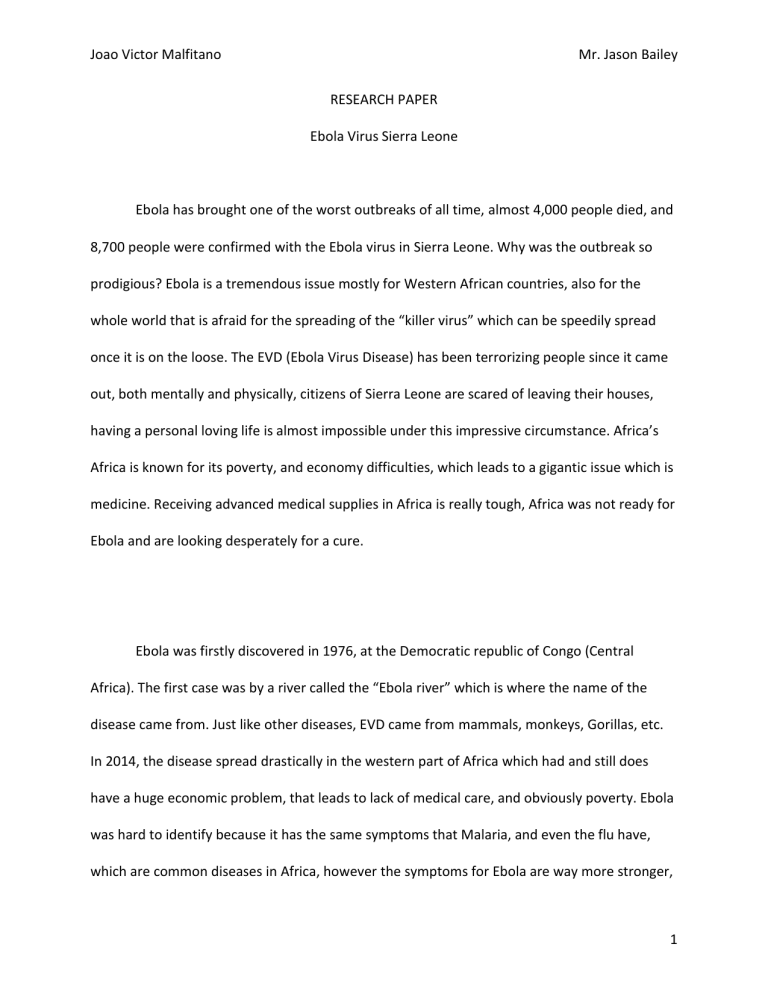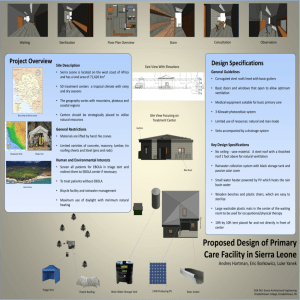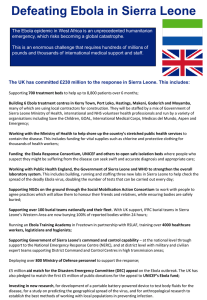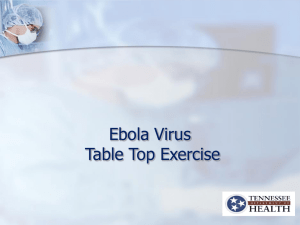
Joao Victor Malfitano Mr. Jason Bailey RESEARCH PAPER Ebola Virus Sierra Leone Ebola has brought one of the worst outbreaks of all time, almost 4,000 people died, and 8,700 people were confirmed with the Ebola virus in Sierra Leone. Why was the outbreak so prodigious? Ebola is a tremendous issue mostly for Western African countries, also for the whole world that is afraid for the spreading of the “killer virus” which can be speedily spread once it is on the loose. The EVD (Ebola Virus Disease) has been terrorizing people since it came out, both mentally and physically, citizens of Sierra Leone are scared of leaving their houses, having a personal loving life is almost impossible under this impressive circumstance. Africa’s Africa is known for its poverty, and economy difficulties, which leads to a gigantic issue which is medicine. Receiving advanced medical supplies in Africa is really tough, Africa was not ready for Ebola and are looking desperately for a cure. Ebola was firstly discovered in 1976, at the Democratic republic of Congo (Central Africa). The first case was by a river called the “Ebola river” which is where the name of the disease came from. Just like other diseases, EVD came from mammals, monkeys, Gorillas, etc. In 2014, the disease spread drastically in the western part of Africa which had and still does have a huge economic problem, that leads to lack of medical care, and obviously poverty. Ebola was hard to identify because it has the same symptoms that Malaria, and even the flu have, which are common diseases in Africa, however the symptoms for Ebola are way more stronger, 1 Joao Victor Malfitano Mr. Jason Bailey the symptoms start with a strong fever, diarrhea, vomiting, abdominal pain, and the final stage hemorrhage that usually is where sick people pass away. Ebola has been a huge problem for people in Sierra Leone, it is often called the “killer virus” by local people. Citizens from Sierra Leone are often exposed to Ebola, making their life limited in many ways, due to the fact that people can get infected by sex, blood, needles, syringes, and being in contact with a person that is sick. In 1991 civil war broke out in Sierra Leone, corporal Foday Sankoh and his Revolutionary United Front begin campaigning against President Momoh, attacking towns close to Liberia. The range of deaths were 20.000 to over 50.000. Many women were also victims of sexual assaults during the war the number varies between 215. 000 to 257.000 assaults, also leaving destroyed buildings, hospitals, houses and most importantly family. Sierra Leone, still has many conflicts between both sides, but with the epidemic the attack numbers are dropping, they didn’t know that this civil war was going to be the worst thing that could’ve ever happened in Sierra Leone, when Ebola broke out in 2014 the hospitals were still at a really bad shape and not ready to handle this epidemic. American scientists are looking desperately for a cure, especially after the incident at Dallas, and Cleveland. There isn’t a cure for Ebola yet, doctors in Sierra Leone are trying their best to work with what they have, they are using simple procedures, such as, medication to support blood pressure, oxygen- therapy, and providing body salts, the treatment is basic and inconsistent. The recovery is based on the patient’s immune system and how he responds to the medications. Scientists are working on two vaccines, and the results so far are really 2 Joao Victor Malfitano Mr. Jason Bailey promising. The first vaccine is called cAd3- Zebov, it uses a chimpanzee derived adenovirus vector with an Ebola virus gene inserted(who.int). The second vaccine is still getting analyzed, it has the same principles as cAd3- Zebov, although it hasn’t been tested yet the name of the vaccine is rVsV- Zebov for the use in Ebola outbreaks caused by the Zaire strain (the strain of the Ebola virus). Sierra Leone has a beautiful coast, many swamps, wooded hills but overall Sierra Leone is a flat country, therefore there are many farmers and farms. In Sierra Leone, the most commonly way of work is farming, unfortunately it is difficult to proceed with this kind of work because of the constant contact with animals, and food. If a worker at a farm is contaminated and he touches animals, and food he can transmit the disease to other people that contact with the animal or with the food. “Due to limited surgical and obstetric skills among health providers and poor functioning of health facilities, obstetric and surgical emergencies cost many lives and disabilities” (operation Ebola, 49). Sierra Leone has a worrying economic issue, since its independence from Britain in 1961. Sierra Leone’s economic score is 47.5, Sierra Leone is ranked 42nd with 47 countries in the Sub- Saharan, and because of its current issues the economy of Sierra Leone is well below when they are compared to the rest of the world. Sierra Leone’s main exports are diamonds, and coffee but what makes Sierra Leone so poor? – The Sierra Leone civil war destroyed many of the infrastructure in Sierra Leone the most importantly hospitals. Sierra Leone hasn’t recovered from its brutal civil war, most of the hospitals in Sierra Leone are still destroyed. Sierra Leone was not ready for this long and painful epidemic. 3 Joao Victor Malfitano Mr. Jason Bailey The most painful, and difficult phase to handle as a survivor of the Ebola virus is the mental warfare, and your mentality. Survivors find it hard to escape the thoughts that goes through their heads after they win the battle against the virus, most of them are scared to go into public places such as malls and, supermarkets because of the fear that they might still transmit the disease. Some people can still transmit the disease after they heal, that is why Ebola is a major concern not just in Sierra Leone but for the whole world, which needs to do whatever it takes to find a cure, and to prevent the spread to other parts of the planet. Ebola never leaves the person, once you get it, you will always have it both mentally and physically, Ebola has a big impact on someone’s person lives, the frustration of transmitting the disease through sex, or any other contact with a man or woman is big. “Ebola-related stigma may have produced unwanted consequences on containment of the epidemic by discouraging suspected patients from seeking care in order to avoid the label of Ebola “(BMJ global Health). Some patients choose to not seek medical care, and in some cases the person does not realize that they have Ebola because of the similarities to the flu, by the time they see that they actually had Ebola, it is too late and they probably will have transmitted the disease to at least 10 people. Education is a big part of the outbreak, knowing when to go get help at a hospital is an important aspect to control an outbreak. The Sierra Leone’s education system has been a challenge. Many teachers are unqualified, most of the teachers do not have their teacher degree, or any degree at all some of the teachers didn’t finish high school. Since scientists don’t have a cure for Ebola, citizens and patients from Sierra Leone are relying on traditional and spiritual healings. Some families would rather use spiritual healing as the number one cure, and that they are stronger and better to heal Ebola. Unfortunately, many 4 Joao Victor Malfitano Mr. Jason Bailey “false” spiritual healers are using this epidemic as bait to make money, families that have been in contact with Ebola, or families that has a parent with the disease. One famous case and practices were salt baths, but it exposes the healer to the disease. Many healers got sick due to the constant exposure to infected people, by falsely claiming that they had the cure to Ebola. Traditional healers, would often attend hospitals or house, and were always in contact with sick people, and many of them also got infected. Traditional healers are usually important to give the patients peace and also the families, because it’s such a horrible disease it really gives only negative thoughts, and under the circumstances that they are in it is important to not give up and to keep fighting. Maternal mortality was already a big problem before Ebola. Maternal mortality is defined by the number of women that died during maternity, Sierra Leone has a huge Maternal mortality rate which is just another impact that the tragic civil war, and now with the Ebola outbreak things are not going well in Sierra Leone. The Ebola Virus Disease outbreak has taken a heavy toll on the entire socio-economic fabric of Sierra Leone. But with support from our international friends, we fought back,” said President Ernest Bai Koroma (president of Sierra Leone). The situation is getting slowly better with members of the UN, doctors volunteering to help this deadly virus, unfortunately nothing was done earlier to avoid the outbreak due to the limited resources that Sierra Leone had at the time, but like president Ernest Bai Koroma mentioned, they only got through this crisis due to their international friends such as the British, the US and the UN countries and organizations that realized that the spread of the disease was the end of the world. Sierra Leone’s president also mentioned at the United Nations General Assembly that they are planning on a post Ebola recovery plan “Whilst we are 5 Joao Victor Malfitano Mr. Jason Bailey making progress to end the epidemic, I commend the United Nations agencies and the international community for their support and commitment to end the epidemic as well as support for the Post-Ebola Recovery Plan”. Ebola is certainty one of the world’s priority, the fear of this horrible disease to somehow leave Sierra Leone and West Africa as a whole is frustrating. The Ebola Virus Disease outbreak was humongous by the fact that the country of Sierra Leone wasn’t fully recovered by the civil war, where many people died and many of its hospitals, and important medical supplies were destroyed. The economy was another concern, just like any country in Africa that got its independence , they had to start their government from scratch, and the economy as well, that’s is why civil war broke out because Sierra Leone was left with many beliefs and not every citizen agreed with the way that the government was built, even though Sierra Leone is known for its diamonds and oil their economy is not good, but luckily countries such as the US, Britain, France and also organizations like the UN helped sending doctors, medicine, and looking non- stop for a cure. Lastly, the lack of medicine, vaccines played a big part on the outbreak, due to how Ebola is invisible, because its commonly mistaken with Malaria, and a flu there wasn’t any time to prepare for it, therefore scientist had to start their vaccine process from scratch, they are almost getting to the result that they want, but there is still a long way to go. Nowadays Ebola almost “dead”, scientists are still looking for a cure getting ready for a possible future outbreak. 6 Joao Victor Malfitano Mr. Jason Bailey “History of Ebola Virus Disease Error Processing SSI File.” Centers for Disease Control and Prevention, Centers for Disease Control and Prevention, 18 Sept. 2018, www.cdc.gov/vhf/ebola/history/summaries.html. “2014-2016 Ebola Outbreak in West Africa | History | Ebola (Ebola Virus Disease) | CDC.” Centers for Disease Control and Prevention, Centers for Disease Control and Prevention, 8 Mar. 2019, www.cdc.gov/vhf/ebola/history/2014-2016-outbreak/index.html. “Signs and Symptoms | Ebola Hemorrhagic Fever | CDC.” Centers for Disease Control and Prevention, Centers for Disease Control and Prevention, 22 May 2018, www.cdc.gov/vhf/ebola/symptoms/index.html. Manguvo, Angellar, and Benford Mafuvadze. “The Impact of Traditional and Religious Practices on the Spread of Ebola in West Africa: Time for a Strategic Shift.” The Pan African Medical Journal, The African Field Epidemiology Network, 10 Oct. 2015, www.ncbi.nlm.nih.gov/pmc/articles/PMC4709130/. Mitchell, Cristina. “| Avoiding Local Transmission of Ebola Is the Goal in Latin America and the Caribbean.” Pan American Health Organization / World Health Organization, 10 Nov. 2014, www.paho.org/hq/index.php?option=com_content&view=article&id=10194:2014-avoidinglocal-transmission-of-ebola-is-the-goal-in-latin-america-and-thecaribbean&Itemid=135&lang=fr. “Ebola | Frequently Asked Questions.” World Health Organization, World Health Organization, 19 Dec. 2018, www.who.int/ebola/drc-2018/faq-vaccine/en/. O’Leary, Ann, et al. “Fear and Culture: Contextualising Mental Health Impact of the 2014–2016 Ebola Epidemic in West Africa.” BMJ Global Health, BMJ Specialist Journals, 1 June 2018, gh.bmj.com/content/3/3/e000924. 7 Joao Victor Malfitano Mr. Jason Bailey Soucheray, Stephanie. “Ebola Outbreak Grows by 19 as WHO Notes 'Stop and Go' Response.” CIDRAP, 15 May 2019, www.cidrap.umn.edu/news-perspective/2019/05/ebolaoutbreak-grows-19-who-notes-stop-and-go-response. Pike, John. “Military.” Sierra Leone - Geography, 23 Aug. 2015, www.globalsecurity.org/military/world/africa/sl-geography.htm. “Sierra Leone.” Sierra Leone Economy: Population, GDP, Inflation, Business, Trade, FDI, Corruption, Feb. 2019, www.heritage.org/index/country/sierraleone. Angel Desai. “Sierra Leone's Long Recovery from the Scars of War.” World Health Organization, World Health Organization, 4 Oct. 2010, www.who.int/bulletin/volumes/88/10/10-031010/en/. “Education in Sierra Leone.” Education in Sierra Leone | Global Partnership for Education, Feb. 2019, www.globalpartnership.org/country/sierra-leone. “Treatment | Ebola (Ebola Virus Disease) | CDC.” Centers for Disease Control and Prevention, Centers for Disease Control and Prevention, 27 Dec. 2017, 8:29am, www.cdc.gov/vhf/ebola/treatment/index.html Nicholas J Beeching, Manual Fenech, and Catherine F Houlihan“Ebola Virus Disease”,BMJ:British Medical Journal, 08 Dec 2014 - 14 Dec 2014 - https://www.jstor.org/stable/10.2307/26518974 “Presidents of Sierra Leone and Liberia Outline Post-Ebola Recovery Plan in Addresses to UN Assembly | Africa Renewal.” United Nations, United Nations, www.un.org/africarenewal/africaga2015/news/presidents-sierra-leone-and-liberia-outlinepost-ebola-recovery-plan-addresses-un-assembly. Wren, Sherry M., and Adam L. Kushner. Operation Ebola: Surgical Care during the West African Outbreak. Johns Hopkins University Press, 2017. 8



